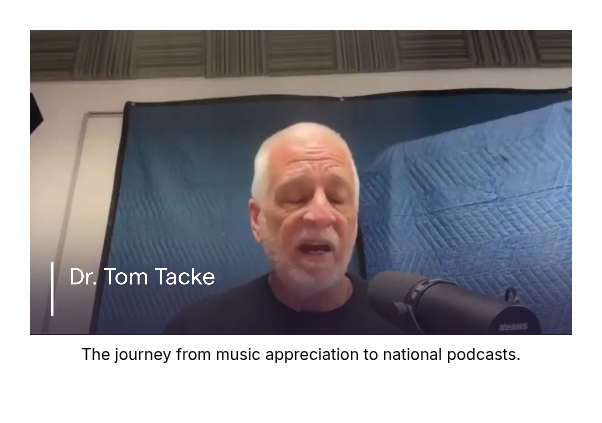
From Music Appreciation to National Podcasts: How Dr. Tom Tacke Turned Chromebooks into a Professional Audio Production Lab
September 23, 2025How one high school teacher transformed student engagement by amplifying voices across subjects - from beats to radio shows that reach national audiences
Table of Contents
A Creative Journey
Dr. Tom Tacke has spent decades in education, but his search for truly hands-on learning experiences led him down an unexpected path. After years of teaching music appreciation at Central Union High School in El Centro, California, he found himself wanting more for his students.
“I get to be in a creative environment every day, helping students find their voice,” Dr. Tacke reflects on his current role as a high school audio production teacher. But this transformation didn’t happen overnight – it began with recognizing what his students were missing.
The Challenge: Beyond Traditional Music Classes
Like many educators, Dr. Tacke faced a common dilemma. His music appreciation classes were engaging, but students craved creation opportunities beyond traditional ensembles.
“The students were missing that hands-on aspect. The creation aspect,” he explains. “We have bands, we have choirs, and we even have a modern rock ensemble at our school. But there was a bulk of students that were needing that type of thing.”
Traditional recording labs with expensive equipment weren’t accessible or scalable for the diverse student population he wanted to serve. The challenge was finding a tool that could deliver professional-quality results without the traditional barriers to entry.
Discovering Professional-Quality Audio on Chromebooks
Dr. Tacke’s skepticism was understandable. Could professional-quality audio production really work on the Chromebooks his students used daily?
“I was in somewhat disbelief that it would work on Chromebooks,” he admits. “I heard the demos and they were great.”
When Central Union High School licensed Soundtrap for Education in fall 2018, that skepticism quickly transformed into amazement. Students who were already experimenting with various audio tools – from GarageBand to Fruity Loops – immediately embraced the platform’s accessibility and quality.
“The quality of the things that they started making almost immediately was just cool,” Dr. Tacke recalls. The combination of familiar interfaces with professional-grade results created an instant connection.
Classroom Growth: From One Section to Five
Student demand told the story of success better than any assessment could. What began as a single experimental section grew organically based on pure student interest.
“I had one section the first year, and then it went to two sections. Then just the success of it and the demand for it went to five sections,” Dr. Tacke explains.
This growth wasn’t driven by administrative mandates or curriculum requirements – it came from students discovering they could create professional-quality audio content with tools they already had access to. The scalability that seemed impossible with traditional recording equipment became seamless with cloud-based collaboration.

Thriving During Remote Learning
While many educators struggled with the shift to online learning, Dr. Tacke’s audio production classes continued thriving. The cloud-based collaboration that seemed like a nice feature suddenly became essential.
“During the COVID year, Soundtrap was a savior because being that it functions in an online environment, it didn’t stop us from doing what we wanted to do,” he reflects. “That was different than almost all my other colleagues.”
The ability to maintain the same quality of collaborative audio production remotely meant his students never lost momentum. “There’s no reason for it not to be the same as a face-to-face classroom,” Dr. Tacke notes, highlighting how the right tools can eliminate traditional barriers to learning continuity.
Student Success Stories: Beats, Battles, and Breakthrough Moments
The real measure of any educational tool lies in student transformation stories. Dr. Tacke’s classroom became a hub of creative competition and collaboration that surprised even him.
One student embraced beat-making so completely that he “started making all of his beat loops in Soundtrap” and “abandoned other products that he was using.” His tagline, “CJ Productions,” became a mark of quality that other students recognized and respected.
Another student discovered the power of sampling, creating mashups that blended SpongeBob samples with Kanye beats. “It was incredibly cool – maybe not real school appropriate, but seriously cool,” Dr. Tacke laughs. “It’s like, wow, this is a very powerful tool.”
These individual successes created a ripple effect. “It created this little battle between a handful of those producers, and they all started trying to outdo each other just a little bit, which was cool. They were collaborative, but they were competitive.”
The engagement extended beyond just musical creation. Students with attendance issues suddenly had reasons to show up. “You’re giving them something real to do that is specialized to what they’re interested in,” Dr. Tacke observes.
From Classroom to Airwaves: National Recognition
What started as classroom projects evolved into content that reached far beyond school walls. Dr. Tacke’s students didn’t just create audio – they found authentic audiences for their voices.
A student-produced holiday rap caught the attention of local radio stations, eventually airing in both California and Memphis. This success opened doors to ongoing partnerships, including a weekly podcast called “Valley Vibes” – a 30-45 minute show featuring “culture, arts and happenings in their lives from the kids’ perspective.”
The recognition continued growing. KPBS, the local PBS affiliate serving San Diego and Imperial Counties, selected Dr. Tacke’s students to create “Voices del Valle,” an 11-episode podcast series that PBS actively promotes. “They’re so excited about it,” Dr. Tacke notes, highlighting how professional media organizations recognize the quality of student work. Tacke’s students also created podcast series – Valley VibeZ – that airs every Sunday morning on the local radio station 98.3 FM – Power98.
The program expanded further with “Inside the Blue Zone,” an athletic podcast where student-athletes share their experiences across different sports seasons. These aren’t just school projects – they’re published on YouTube and Spotify, giving students real-world publishing experience.
Ready to get started with podcasting but not sure where to start? Check out our guide to creating student podcasts
The Power of Student Voice
Behind all these success stories lies a simple but powerful truth: students want to be heard, but educational systems don’t always provide meaningful opportunities for authentic expression.
“They want to be heard, but I don’t think we usually hear them,” Dr. Tacke reflects. “They’re that generation of TikTok and Instagram, and this is providing a pretty cool tool for them.”
Audio production became a bridge between students’ natural inclination to create and share content and academic learning objectives. Whether they’re producing music, telling coming-of-age stories, or interviewing athletes, students develop research, writing, collaboration, and technical skills that connect directly to career readiness goals.
The quality of student work matters deeply. “It’s giving them something tangible and real to do that has a high-quality result,” Dr. Tacke explains. “Instead of just little daily exercises that have very little bearing on anything.”
Need ready-made curriculum for student podcast projects? We rounded up the top 7 Soundtrap podcasting curriculum here

Key Takeaways for Educators
Dr. Tacke’s eight-year journey with Soundtrap offers several insights for educators considering audio production in their classrooms:
Accessibility Transforms Participation Working on familiar devices like Chromebooks eliminates technical barriers that traditionally limited creative programs to students with specialized equipment access.
Quality Drives Engagement When students can produce professional-sounding results immediately, they invest more deeply in the creative process and take ownership of their learning.
Cross-Curricular Applications Emerge Naturally While starting in music education, Dr. Tacke’s program now supports storytelling, journalism, athletics, and social studies through podcast projects that build literacy and communication skills.
Authentic Audiences Motivate Excellence Knowing their work might reach radio audiences or podcast listeners pushes students to higher standards than traditional classroom-only assignments.
Differentiation Happens Organically “I can differentiate my instruction really easily,” Dr. Tacke notes. “I have my standards and goals that I want to meet, but how they meet it is up to them.”
Alternative Assessment Reveals Hidden Understanding Audio projects allow students to demonstrate knowledge in ways that traditional written assessments might miss, particularly benefiting learners who think and express themselves differently.
Get Started with Audio Production
Dr. Tacke’s transformation from music appreciation teacher to audio production innovator demonstrates what becomes possible when the right tools meet educator creativity and student passion. His students aren’t just learning about audio – they’re developing skills in research, writing, collaboration, and digital media that prepare them for modern careers.
The key insight from Dr. Tacke’s experience: start with student voice, provide professional-quality tools, and watch authentic learning emerge.
“I could have retired a couple years ago. I haven’t yet,” Dr. Tacke reflects on how this work has re-energized his teaching career. “It means something that way too.”
Want to see how audio production can amplify student voices in your classroom?
Request a demo to explore curriculum-aligned projects that transform how students demonstrate learning across subjects.
About Dr. Tom Tacke Dr. Tom Tacke teaches audio production at Central Union High School in El Centro, California. Since implementing Soundtrap for Education in 2017, his program has grown from one section to five, with students producing content for local radio stations, PBS podcasts, and national media outlets. His work demonstrates how accessible audio production tools can amplify student voices while building critical 21st-century skills.
This story is part of our 10-year anniversary celebration of Soundtrap for Education, highlighting educators who transform learning by amplifying student creativity and voice across all subjects.
 EDU Portal
EDU Portal



